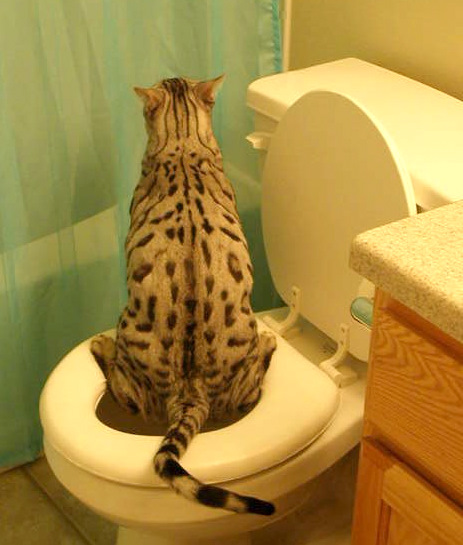The Risks of Flushing Cat Poop in Your Toilet - Preventive Steps
The Risks of Flushing Cat Poop in Your Toilet - Preventive Steps
Blog Article
Right here in the next paragraph you will find a good deal of helpful points related to Don’t flush cat feces down the toilet.

Intro
As cat proprietors, it's important to be mindful of just how we take care of our feline pals' waste. While it may appear convenient to purge cat poop down the bathroom, this technique can have harmful effects for both the environment and human health and wellness.
Alternatives to Flushing
Fortunately, there are much safer and extra responsible methods to throw away cat poop. Consider the complying with choices:
1. Scoop and Dispose in Trash
One of the most usual method of throwing away pet cat poop is to scoop it right into an eco-friendly bag and toss it in the trash. Be sure to utilize a devoted trash scoop and get rid of the waste quickly.
2. Use Biodegradable Litter
Go with eco-friendly pet cat trash made from products such as corn or wheat. These litters are environmentally friendly and can be securely taken care of in the garbage.
3. Hide in the Yard
If you have a backyard, think about burying cat waste in a designated location far from veggie gardens and water sources. Be sure to dig deep enough to stop contamination of groundwater.
4. Mount a Pet Waste Disposal System
Invest in a pet garbage disposal system especially developed for cat waste. These systems make use of enzymes to break down the waste, decreasing odor and environmental impact.
Wellness Risks
Along with ecological worries, purging cat waste can likewise pose wellness threats to human beings. Feline feces might include Toxoplasma gondii, a bloodsucker that can create toxoplasmosis-- a possibly severe disease, particularly for pregnant ladies and individuals with weakened immune systems.
Environmental Impact
Flushing pet cat poop introduces harmful pathogens and parasites right into the supply of water, presenting a significant risk to marine ecological communities. These impurities can negatively impact aquatic life and compromise water high quality.
Verdict
Accountable pet possession prolongs past offering food and shelter-- it likewise includes proper waste monitoring. By avoiding purging cat poop down the bathroom and going with different disposal methods, we can minimize our ecological impact and secure human health and wellness.
Why Can’t I Flush Cat Poop?
It Spreads a Parasite
Cats are frequently infected with a parasite called toxoplasma gondii. The parasite causes an infection called toxoplasmosis. It is usually harmless to cats. The parasite only uses cat poop as a host for its eggs. Otherwise, the cat’s immune system usually keeps the infection at low enough levels to maintain its own health. But it does not stop the develop of eggs. These eggs are tiny and surprisingly tough. They may survive for a year before they begin to grow. But that’s the problem.
Our wastewater system is not designed to deal with toxoplasmosis eggs. Instead, most eggs will flush from your toilet into sewers and wastewater management plants. After the sewage is treated for many other harmful things in it, it is typically released into local rivers, lakes, or oceans. Here, the toxoplasmosis eggs can find new hosts, including starfish, crabs, otters, and many other wildlife. For many, this is a significant risk to their health. Toxoplasmosis can also end up infecting water sources that are important for agriculture, which means our deer, pigs, and sheep can get infected too.
Is There Risk to Humans?
There can be a risk to human life from flushing cat poop down the toilet. If you do so, the parasites from your cat’s poop can end up in shellfish, game animals, or livestock. If this meat is then served raw or undercooked, the people who eat it can get sick.
In fact, according to the CDC, 40 million people in the United States are infected with toxoplasma gondii. They get it from exposure to infected seafood, or from some kind of cat poop contamination, like drinking from a stream that is contaminated or touching anything that has come into contact with cat poop. That includes just cleaning a cat litter box.
Most people who get infected with these parasites will not develop any symptoms. However, for pregnant women or for those with compromised immune systems, the parasite can cause severe health problems.
How to Handle Cat Poop
The best way to handle cat poop is actually to clean the box more often. The eggs that the parasite sheds will not become active until one to five days after the cat poops. That means that if you clean daily, you’re much less likely to come into direct contact with infectious eggs.
That said, always dispose of cat poop in the garbage and not down the toilet. Wash your hands before and after you clean the litter box, and bring the bag of poop right outside to your garbage bins.
https://trenchlesssolutionsusa.com/why-cant-i-flush-cat-poop/

I recently found that piece on Don’t flush cat feces down the toilet when surfing around the internet. You should take the opportunity to share this write-up if you liked it. Thank you for your time spent reading it.
Visit Our Site Report this page